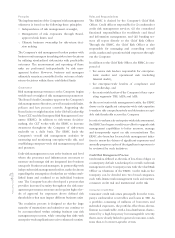American Express 2004 Annual Report Download - page 43
Download and view the complete annual report
Please find page 43 of the 2004 American Express annual report below. You can navigate through the pages in the report by either clicking on the pages listed below, or by using the keyword search tool below to find specific information within the annual report.
standby letters of credit and guarantees. Additionally,
at December 31, 2004 the Company had $662 million
of loan commitments and other lines of credit as well
as $646 million of bank standby letters of credit, bank
guarantees and bank commercial and other bank let-
ters of credit that were outside the scope of FIN 45.
See Note 10 to the Consolidated Financial Statements for
further discussion regarding the Company’s guarantees.
Retained interests in assets transferred to
unconsolidated entities
The Company held, as an investment, $108 million of
subordinated retained interests from securitizations
and $207 million of an interest-only strip in the card-
member loan securitization trust at December 31, 2004.
See the TRS Liquidity and Capital Resources section
and Note 4 to the Consolidated Financial Statements for
details regarding TRS’ securitization trusts.
Additionally, the Company, through its AEFA segment,
held as an investment $705 million of retained interests
in a CDO-related securitization trust at December 31,
2004. Of that total, approximately $523 million is con-
sidered investment grade. The securitization was the
result of the Company placing a majority of its rated
CDO securities into a trust in 2001. The rated CDO
securities were held as part of the Company’s invest-
ment strategy in order to pay a competitive rate to con-
tract holders within the AEFA operating segment. One
of the results of this transaction was that increases and
decreases in future cash flows of the individual CDOs
are combined into one overall cash flow for purposes
of determining the carrying value of the retained inter-
ests and related impact on the results of operations.
Unconsolidated variable interest entities
At December 31, 2004, the Company had interests in
unconsolidated variable interest entities including
$375 million of investments in affordable housing part-
nerships and CDO residual tranches with a carrying
value of $27 million which are managed by the Com-
pany. The affordable housing partnership interests and
the CDO residual tranches were obtained as part of the
overall investment strategies and as a condition of man-
aging certain CDOs that generate management fee
income for the Company. The Company has no mate-
rial future obligations associated with these entities
beyond the carrying values. These structures were not
impacted by the consolidation provisions of FIN 46, as
the Company is not the primary beneficiary. See the
AEFA Liquidity and Capital Resources section and
Note 5 to the Consolidated Financial Statements for fur-
ther discussion regarding the Company’s interests in
variable interest entities.
Certain Other Off-Balance Sheet Arrangements
At December 31, 2004, the Company had $176 billion
of unused credit available to cardmembers, as part of
established lending product agreements. Total unused
credit available to cardmembers does not represent
potential future cash requirements as a significant por-
tion of this unused credit will likely not be drawn. The
Company’s charge card products have no pre-set limit
and, therefore, are not reflected in unused credit avail-
able to cardmembers. As discussed in the TRS Liquidity
and Capital Resources section, the Company’s securi-
tizations of cardmember loans are also off-balance
sheet. The Company’s cardmember receivables securi-
tizations remain on the Consolidated Balance Sheets.
See Note 10 to the Consolidated Financial Statements
for further discussion regarding the Company’s other
off-balance sheet arrangements.
American Express Company Risk Management
Introduction
Risk management is a key lever in driving profitable
growth at the Company. By creating transparent limits
on risk exposures, optimizing investment decision-
making and identifying unacceptable risks, risk man-
agement plays a fundamental role in the Company’s
efforts to create shareholder value.
In addition to business risk, the Company recognizes
three fundamental sources of risk:
©Credit Risk,
©Market Risk, and
©Operational Risk.
These risk types are interrelated and span the Compa-
ny’s business units and geographic locations. Given the
nature and scope of these risks, the Company believes
in centrally managing them at an enterprise level. Fur-
ther, management has adopted well-defined principles
regarding credit, market and operational risk to guide
the Company’s business strategy and achieve long-
term shareholder objectives. The Company views
underwriting credit risk as a significant lever in driving
profitable growth. Market risk is hedged or managed
within established parameters to sustain such earnings
growth, while operational risk arising from the Compa-
ny’s business activities is carefully monitored to main-
tain it within acceptable limits.
AXP
AR.04
41
Financial Review
























